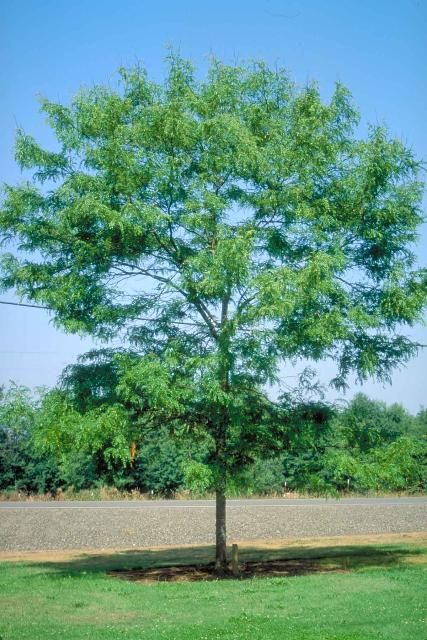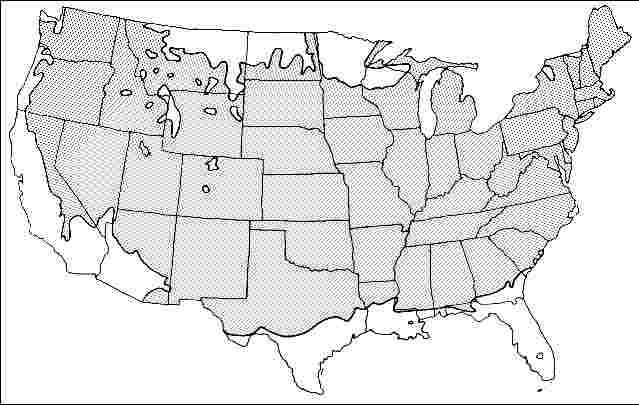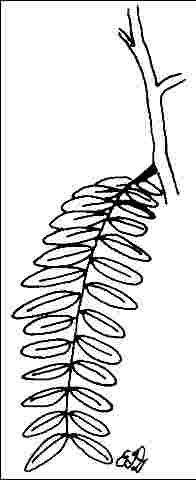Introduction
`Skyline' Honeylocust grows quickly to 50 feet or more with a rounded canopy comprised of several dominant ascending branches. Young trees may be more pyramidal with a central trunk. A central leader usually develops with little encouragement and the tree will require little pruning. This makes the tree well suited for street tree planting since lower branches can be removed without deforming the nice shape of the crown. The species has undesirable thorns on the trunk and main branches and large seed pods but this cultivar is almost seedless. The tree is strong-wooded and casts light shade. Lawns grow fairly well beneath the tree and there is little to rake up in the fall since the tiny leaflets filter in between the blades of grass or are washed away in the rain. Honeylocust has a yellow or golden fall color in the northern part of its range. Trees often defoliate early in the south and are bare by October.

Credit: Ed Gilman
General Information
Scientific name: Gleditsia triacanthos var. inermis
Pronunciation: gleh-DIT-see-uh try-uh-KANTH-oase variety ih-NER-miss
Common name(s): 'Skyline' Thornless Honeylocust
Family: Leguminosae
USDA hardiness zones: 4A through 8A (Fig. 2)
Origin: native to North America
Invasive potential: little invasive potential
Uses: urban tolerant; street without sidewalk; shade; specimen; parking lot island > 200 sq ft; sidewalk cutout (tree pit); tree lawn > 6 ft wide; highway median; reclamation
Availability: not native to North America

Description
Height: 50 to 75 feet
Spread: 35 to 50 feet
Crown uniformity: symmetrical
Crown shape: pyramidal
Crown density: moderate
Growth rate: fast
Texture: fine
Foliage
Leaf arrangement: alternate (Fig. 3)
Leaf type: bipinnately compound, odd-pinnately compound
Leaf margin: crenate
Leaf shape: oblong, lanceolate
Leaf venation: pinnate
Leaf type and persistence: deciduous
Leaf blade length: less than 2 inches
Leaf color: green
Fall color: yellow, copper
Fall characteristic: showy

Flower
Flower color: yellow
Flower characteristics: not showy
Fruit
Fruit shape: no fruit
Fruit length: no fruit
Fruit covering: no fruit
Fruit color: no fruit
Fruit characteristics: no fruit
Trunk and Branches
Trunk/bark/branches: branches droop; not showy; typically one trunk; thorns
Pruning requirement: little required
Breakage: resistant
Current year twig color: brown
Current year twig thickness: thin
Wood specific gravity: unknown
Culture
Light requirement: full sun, partial sun or partial shade
Soil tolerances: sand; loam; clay; acidic; alkaline; occasionally wet; well-drained
Drought tolerance: high
Aerosol salt tolerance: high
Other
Roots: can form large surface roots
Winter interest: yes
Outstanding tree: no
Ozone sensitivity: unknown
Verticillium wilt susceptibility: resistant
Pest resistance: resistant to pests/diseases
Use and Management
The tree has no particular soil preferences and is useful in dry or alkaline areas, although its native habitat is along stream banks. It tolerates compacted, poorly aerated soil and flooding for a period of time and does well in confined soil spaces. Honeylocust adapts well as a city street tree and is tolerant to small planting pits in concrete. Unfortunately, it has been overplanted in some areas and insect problems are beginning to catch up with Honeylocust, including the cultivars. Recommend planting only small numbers of this tree to avoid catastrophe if insects or diseases invade. It might be best to plant Pistacia, Zelkova, Taxodium, Quercus, or some other proven urban tough tree in place of Honeylocust to avoid potential insect, disease and early defoliation problems in the deep south.
Most garden centers will have at least one cultivar of Honeylocust in stock. Some of the cultivars may develop thorns and/or seed pods when they get older and they may be best suited for areas north of USDA hardiness zone 8b. The cultivars are: `Cottage Green' - semi upright, seedless, thornless; `Imperial' - spreading, seedless, and thornless until 10 to 15-years-old when some seeds do develop; `Majestic' - upright, seedless, thornless; `Maxwell' - upright, seedless, thornless; `Moraine' - spreading, usually seedless, thornless; `Rubylace' - new reddish foliage, seedless, thornless, color not outstanding, may need staking when young; `Shademaster' - upright, spreading, usually seedless and thornless until 10 to 15-years-old when some seeds do develop - perhaps the best cultivar; `Skyline' - pyramidal in youth, generally seedless, thornless; `Sunburst' - new yellow foliage, seedless, thornless, favored by plant bugs and leafhoppers.
Pests
Mimosa webworm has become a serious pest on Honeylocust in some communities.
Boring insects may be largely prevented by keeping trees healthy with regular fertilization. They usually attack trees under stress from other problems.
The combination of plant bug and leafhopper feeding causes the leaves to drop. Plant bugs may be more common on the yellow leaved cultivar `Sunburst' than on green leaved types. Both insects are green so they will be hard to detect.
Pod gall midge causes unusual reddish galls at the tips of the branches. Leaflets become pod-like. The galls appear in late spring and may be most common on thornless, seedless cultivars. These have become quite a problem in many areas. Control is difficult.
Spider mites cause an autumn-like yellowing of the leaves. Diagnosis of this problem is difficult due to the small size of the insect and leaflets. Look for the mites and their webbing near the midrib at the base of the leaflets.
Leafminers and bagworm can also be a problem.
Diseases
Canker causing fungi or bacteria attack branches and trunks causing dieback of parts or the entire tree. Keep the trees healthy and avoid unnecessary wounding. Infected areas have discolored bark, peeling bark, discolored sapwood, or a crack between the diseased and healthy bark. The ronectria canker is especially damaging.
There is a leaf spot may be a problem. Rake up and dispose of infected leaves.
Powdery mildew may cause a white coating on the leaves but is seldom serious.
